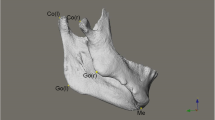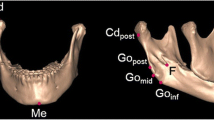Abstract
Objectives
The aim of this study was to evaluate the characteristics affecting different intensities of mandibular asymmetry in skeletal Class II adults using three-dimensional images. This study is clinically relevant since it allows professionals to evaluate the morphological components related to these deformities and more carefully obtain correct diagnosis and treatment plan for such patients.
Methods
Cone-beam computed tomography data of 120 Class II patients (40 with relative symmetry, 40 with moderate asymmetry, and 40 with severe asymmetry) were imported to SimPlant Ortho Pro® 2.0 software (Dental Materialise, Leuven, Belgium). Three reference planes were established and linear measurements were performed from specific landmarks to these planes, comparing the deviated side and the contralateral side in each group, as well as the differences between groups. The correlation between midline mandibular asymmetry and other variables was also evaluated. Statistical analyses considered a significance level of 5%.
Results
Comparing the values obtained on the deviated side and on the contralateral side, there were significant differences for patients with moderate asymmetry and severe asymmetry. However, differences were seen more often in severe mandibular asymmetries. In those patients, there was a significant correlation of the gnathion deviation with lower dental midline deviation, difference in the lateral gonion positions, difference in the mandibular rami heights, and difference in the jugale vertical displacements.
Conclusions
For skeletal Class II patients with mandibular asymmetry, some craniofacial features are related to chin deviation and require proper evaluation, including the bilateral differences in the ramus height, mandibular body length, transverse and vertical positioning of the gonion and jugale points.
Zusammenfassung
Ziele
In der Studie sollten mittels dreidimensionaler Bildgebung die Charakteristika evaluiert werden, welche die unterschiedlich starke Ausprägung von Unterkieferasymmetrien bei erwachsenen Klasse-II-Patienten beeinflussen. Die klinische Relevanz der Untersuchung besteht darin, dass sie die Möglichkeit bietet, mit diesen Deformitäten verbundene morphologische Komponenten zu evaluieren und auf sorgfältigere Weise sowohl die zutreffende Diagnose zu stellen als auch die Behandlung zu planen.
Methoden
Daten der digitalen Volumentomographien (DVT) von 120 Klasse-II-Patienten (40 mit relativer Symmetrie sowie 40 mit mäßiger und 40 mit ausgeprägter Asymmetrie) wurden in die Software SimPlant Ortho Pro® 2.0 (Dental Materialise, Leuven, Belgien) importiert. Anhand von 3 definierten Bezugsebenen und spezifischen Referenzpunkten wurden Messungen durchgeführt, um die abweichende und die kontralaterale Seite miteinander zu vergleichen und um Intergruppenunterschiede zu ermitteln. Ebenso evaluiert wurde die Korrelation zwischen Mittellinienasymmetrie und anderen Variablen. Als Signifikanzniveau für die statistischen Berechnungen wurde p = 0,05 festgelegt.
Ergebnisse
Zwischen den Werten auf der abweichenden und der kontralateralen Seite zeigten sich statistisch signifikante Unterschiede für Patienten mit mäßiger und mit ausgeprägter Asymmetrie. Allerdings ließen sich häufiger Unterschiede beobachten bei den ausgeprägten Unterkieferasymmetrien. Bei diesen Patienten bestanden eine signifikante Korrelation zwischen der Gnathion-Abweichung und der unteren dentalen Mittellinienabweichung, ein Unterschied in den Gnathion-Positionen, ein Unterschied in den Höhen der Rami und in den Längen des Corpus mandibulae und ein Unterschied in den transversalen und vertikalen Abweichungen der Punkte Gonion und Jugale.
Schlussfolgerungen
Bei skelettalen Klasse-II-Patienten stehen einige kraniofaziale Besonderheiten—u. a. bilaterale Unterschiede in der Ramushöhe, der Unterkieferlänge sowie der horizontalen und vertikalen Positionierung der Punkte Gonion und Jugale—in Beziehung zu Abweichungen des Kinns. Diese Eigenschaften sind angemessen zu evaluieren.

Similar content being viewed by others
References
Al-Khateeb EA, Al-Khateeb SN (2009) Anteroposterior and vertical components of Class II division 1 and division 2 malocclusion. Angle Orthod 79(5):859–866
American Academy of Oral and Maxillofacial Radiology (2013) Clinical recommendations regarding use of cone beam computed tomography in orthodontic treatment. Oral Surg Oral Med Oral Pathol Oral Radiol 116(2):238–257
Angle EH (1907) Treatment of malocclusion of the teeth, 7th edn. SS White Manufacturing, Philadelphia
Ast DB, Carlos JP, Cons DC (1965) Prevalence and characteristics of malocclusion among senior high school students in up-state New York. Am J Orthod 51(6):437–445
Burgersdijk R, Truin GJ, Frankenmolen F, Kalsbeek H, van’t Hof M, Mulder J (1991) Malocclusion and orthodontic treatment need of 15-74-year-old Dutch adults. Community Dent Oral Epidemiol 19(2):64–67
Celikoglu M, Akpinar S, Yavuz I (2010) The pattern of malocclusion in a sample of orthodontic patients from Turkey. Med Oral Patol Oral Cir Bucal 15(5):e791–e796
Chen YJ, Yao CC, Chang ZC, Lai HH, Lu SC, Kok SH (2016) A new classification of mandibular asymmetry and evaluation of surgical-orthodontic treatment outcomes in Class III malocclusion. J Craniomaxillofac Surg 44(6):676–683
Damstra J, Fourie Z, DeWit M, Ren Y (2012) A three-dimensional comparison of a morphometric and conventional cephalometric midsagittal planes for craniofacial asymmetry. Clinical Oral Investig 16(1):285–294
Emrich RE, Brodie AG, Blayney JR (1965) Prevalence of Class 1, Class 2, and Class 3 malocclusions (Angle) in an urban population. An epidemiological study. J Dent Res 44(5):947–953
Gateno J, Xia JJ, Teichgraeber JF (2011) New 3-dimensional cephalometric analysis for orthognathic surgery. J Oral Maxillofac Surg 69(3):606–622
Hajeer MY, Ayoub AF, Millett DT (2004) Three-dimensional assessment of facial soft-tissue asymmetry before and after orthognathic surgery. Br J Oral Maxillofac Surg 42(5):396–404
Haraguchi S, Takada K, Yasuda Y (2002) Facial asymmetry in subjects with skeletal Class III deformity. Angle Orthod 72(1):28–35
Hwang HS, Hwang CH, Lee KH et al (2006) Maxillofacial 3-dimensional image analysis for the diagnosis of facial asymmetry. Am J Orthod Dentofac Orthop 130(6):779–785
Kim EJ, Palomo JM, Kim SS, Lim HJ, Lee KM, Hwang HS (2011) Maxillofacial characteristics affecting chin deviation between mandibular retrusion and prognathism patients. Angle Orthod 81(6):988–993
Kim SJ, Lee KJ, Lee SH, Baik HS (2013) Morphologic relationship between the cranial base and the mandible in patients with facial asymmetry and mandibular prognathism. Am J Orthod Dentofac Orthop 144(3):330–340
Masuoka N, Momoi Y, Ariji Y, Nawa H, Muramatsu A, Goto S, Ariji E (2005) Can cephalometric indices and subjective evaluation be consistent for facial asymmetry? Angle Orthod 75(4):651–655
Masuoka N, Muramatsu A, Ariji Y, Nawa H, Goto S, Ariji E (2007) Discriminative thresholds of cephalometric indexes in the subjective evaluation of facial asymmetry. Am J Orthod Dentofac Orthop 131(5):609–613
McNamara JA Jr (1981) Components of Class II malocclusion in children 8–10 years of age. Angle Orthod 51(3):177–202
Minich CM, Araújo EA, Behrents RG, Buschang PH, Tanaka OM, Kim KB (2013) Evaluation of skeletal and dental asymmetries in angle Class II subdivision malocclusions with cone-beam computed tomography. Am J Orthod Dentofac Orthop 144(1):57–66
Ovsenik M, Perinetti G, Zhurov A, Richmond S, Primozic J (2014) Three-dimensional assessment of facial asymmetry among pre-pubertal class III subjects: a controlled study. Eur J Orthod 36(4):431–435
Proffit WR, Fields HW Jr, Moray LJ (1998) Prevalence of malocclusion and orthodontic treatment need in the United States: estimates from the NHANES III survey. Int J Adult Orthod Orthognath Surg 13(2):97–106
Quinto-Sánchez M, Adhikari K, Acuña-Alonzo V et al (2015) Facial asymmetry and genetic ancestry in Latin American admixed populations. Am J Phys Anthropol 157(1):58–70
Sanders DA, Rigali PH, Neace WP, Uribe F, Nanda R (2010) Skeletal and dental asymmetries in Class II subdivision malocclusions using cone-beam computed tomography. Am J Orthod Dentofac Orthop 138(5):542.e1-20
Schwartz HC (2011) Efficient surgical management of mandibular asymmetry. J Oral Maxillofac Surg 69(3):645–654
SEDENTEXCT project (2012) Radiation protection no. 172: cone beam CT for dental and maxillofacial radiology. Evidence based guidelines 2012. http://www.sedentexct.eu/content/guidelines-cbct-dental-and-maxillofacial-radiology. Accessed Nov 10 2016.
Severt TR, Proffit WR (1997) The prevalence of facial asymmetry in the dentofacial deformities population at the University of North Carolina. Int J Adult Orthodon Orthognath Surg 12(3):171–176
Sievers MM, Larson BE, Gaillard PR, Wey A (2012) Asymmetry assessment using cone beam CT A Class I and Class II patient comparison. Angle Orthod 82(3):410–417
Thiesen G, Gribel BF, Pereira KCR, Freitas MPM (2016) Is there an association between skeletal asymmetry and tooth absence? Dental Press J Orthod 21(4):73–79
Thiesen G, Gribel BF, Freitas MPM (2015) Facial asymmetry: a current review. Dental Press J Orthod 20(6):110–125
Tweed C (1954) The frankfort-mandibular incisor angle (FMIA) in orthodontic diagnosis, treatment planning and prognosis. Angle Orthod 24(3):121–169
Willems G, De Bruyne I, Verdonck A, Fieuws S, Carels C (2001) Prevalence of dentofacial characteristics in a Belgian orthodontic population. Clin Oral Investig 5(4):220–226
Author information
Authors and Affiliations
Corresponding author
Ethics declarations
Conflict of interest
G. Thiesen, B. F. Gribel, M. P. M. Freitas, D. R. Oliver, and K. B. Kim declare that they have no conflict of interest.
Human and animal rights statement
This study had no funding. All procedures performed in studies involving human participants were in accordance with the ethical standards of the institutional and/or national research committee and with the 1964 Helsinki declaration and its later amendments or comparable ethical standards.
Informed consent
Informed consent was obtained from all individual participants included in the study. For this retrospective study, the Ethics Committee dismissed formal consent.
Additional information
Professor Guilherme Thiesen.
Rights and permissions
About this article
Cite this article
Thiesen, G., Gribel, B.F., Freitas, M.P.M. et al. Craniofacial features affecting mandibular asymmetries in skeletal Class II patients. J Orofac Orthop 78, 437–445 (2017). https://doi.org/10.1007/s00056-017-0100-6
Received:
Accepted:
Published:
Issue Date:
DOI: https://doi.org/10.1007/s00056-017-0100-6




